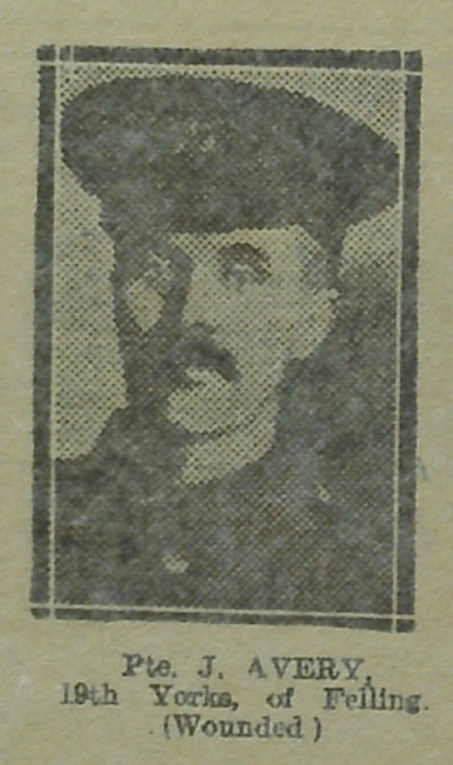
John Avery was a miner and lived at Felling on Tyne, Co. Durham. He was married to Elizabeth Anne Speight. He was 29 years old when he enlisted at the outbreak of war and was initially posted to the 10th Battalion but subsequently served in the 11th and 8th.
John suffered a gunshot wound to two fingers on his right hand in September 1915 and subsequently from the effects of gassing and shell shock. He was posted to the reserves in early 1917 and sent to work at Heworth Colliery, Felling on Tyne. Due to his wounds he was unable to work full weeks and he applied for a disability pension. He was granted 12 shillings and 6 pence a week to rise to 13/9d and subject to review after 48 weeks.
He was awarded the 14/15 Star, the British War Medal , the Victory Medal and a Silver War Badge.
Explore more memories from the ribbon
-
Pte J F Firby
Private Firby was born in 1883 and came from Richmond, living at 49 Newbiggin. He enlisted on 12th December 1914 at the age of 31. He was a ‘Commission Agent’. He was posted to the 6th battalion on 24th August 1915 and arrived in Gallipoli on 8th September. He was wounded by shrapnel on 25th October 1915 when, according to the Battalion War Diary, at 9.30 in the morning there was a ‘Fire display by the Turks along whole of the front. 8 men wounded by shrapnel.’ He returned home on 15th November 1915. He appears among the list of wounded in the December 1915 edition of The Green Howards Gazette. On recovering from his wounds, Private Firby was transferred to the Labour Corps on 22nd May 1917 and he saw out the remainder of the war with the Labour Corps. Private Firby was examined by a Medical Board on 9th March 1917 and was in The Royal Victoria Hospital, Edinburgh on 29th July 1918 when a copy of The New Testament was presented to him. Private Firby was discharged from military service on 4th April 1919. Private Firby was again examined in 1920 and 1921 and declared to have a 40% disability, the cause being listed as ‘Bronchitis’ and granted an award of 8 shillings per week.
-
Albany D Scott
Albany was born on the 18th April 1882 to Robert Scott and Elizabeth Bridgwood in Bradford, Yorkshire and was 32 years old when war broke out. He was married to his wife Mary Ascough, had two young children, son Kenneth and daughter Olive. He had a job as an estate gardener and lived in a tied cottage in Snainton, Yorkshire. He enlisted in Scarborough and it is unclear why he joined the war effort with the Territorial Force but it was said he was not a drinker and had numerous Temperance Medals to prove so! He began his military career as a member of the Territorial Force with the service number 5506. His medal roll adds that he was in both the 6th and then the 5th Battalions of the Yorkshire Regiment, before he was transferred into the 2nd Battalion Yorkshire Regiment in 1916, with a new service number of 242699, possibly first seeing action at the southern end of the British Somme offensive line and at the battle of Transloy Ridges, in October 1916. During this time period he came home wounded, was allowed to recuperate, and once he was fit, he returned back to the front line in early 1917. During the German Spring Offensive of 1918, the Germans grouped in thick fog and overran the trenches where Albany was fighting and took him, along with many others, prisoner on March 22nd. Unfortunately a shell exploded nearby and captors and captured alike were killed. He was 4 weeks…
-
Fred Ward
Submitted by Jon Bemrose. Private Fred Ward (50236) born 1898 in East Yorkshire. Working as a lad porter on the railway at Ampleforth before joining up. Joined the Green Howards at Richmond, but he was transfered to the Northumberland Fusiliers. Fred was in France, near Arras in early 1917 – Jon states: “The fateful day was the Battle of Arras, Easter Monday 9th April. It must have been terrible, having heard and seen all the death and destruction that had occurred before they set off at around 9:00am. My best guess is that they reached the “Blue” line, where they were hit by machinegun fire. Whether initially buried by shell fire or his comrades, Fred was later found and finally burried at Orchard Dump Cemetery, Arleux en Gohelle. I visited his grave in 2016, the first of the family to do so I am led to believe.”
